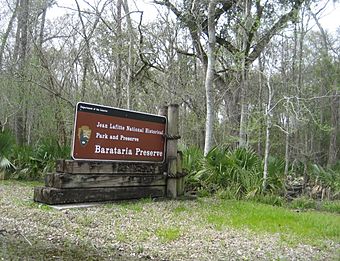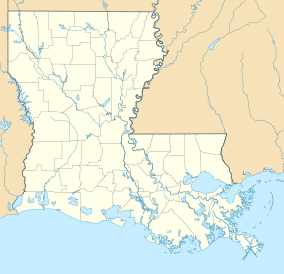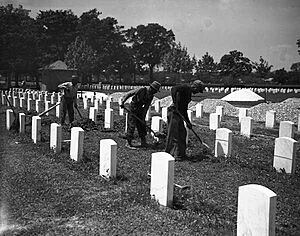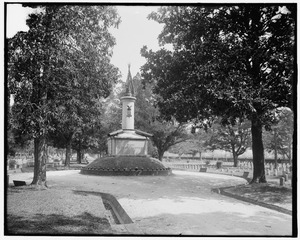Jean Lafitte National Historical Park and Preserve facts for kids
Quick facts for kids Jean Lafitte National Historical Park and Preserve |
|
|---|---|
|
IUCN Category V (Protected Landscape/Seascape)
|
|

Barataria Preserve
|
|
| Location | South Louisiana |
| Nearest city | New Orleans and Lafayette, Louisiana |
| Area | 25,876 acres (104.72 km2) 21,081 acres (8,531 ha) federal |
| Established | March 4, 1907 |
| Visitors | 456,666 (in 2017) |
| Governing body | National Park Service |
| Website | Jean Lafitte National Historical Park and Preserve |
The Jean Lafitte National Historical Park and Preserve helps protect the amazing nature and rich history of Louisiana's Mississippi River Delta area. It's named after a famous French pirate, Jean Lafitte. The park is made up of six different locations and a main office. It's a great place to learn about Louisiana's unique culture and beautiful wetlands.
Contents
Exploring Cajun Culture
Three special places in the park teach visitors about Cajun culture. This culture grew in southern Louisiana, especially around Lafayette. It started when people called Acadians moved there. They had been forced to leave Canada by the British between 1755 and 1764. Later, French Louisiana became part of Spain.
- Acadian Cultural Center in Lafayette
- Prairie Acadian Cultural Center in Eunice
- Wetlands Acadian Cultural Center in Thibodaux
Discovering Nature at Barataria Preserve
|
Barataria Unit of Jean Lafitte Historical Park Historic District
|
|
 |
|
| Area | 1,855 acres (751 ha) |
|---|---|
| NRHP reference No. | 66000966 |
| Added to NRHP | October 15, 1966 |
The Barataria Preserve is located in Marrero. It shows off the natural beauty and history of the region. You can walk on trails or take canoe tours through thick forests, swamps, and marshy areas. An Education Center offers programs for school groups. There is also a visitor center with a film and exhibits to help you learn more. This preserve covers about 1,855 acres (751 ha) and was recognized as a historic district in 1966.
Chalmette Battlefield and Cemetery
The Chalmette Battlefield and National Cemetery is in Chalmette, Louisiana. It's about six miles (10 km) southeast of New Orleans. This is where the famous Battle of New Orleans happened in 1815. This site is very important to the history of both New Orleans and the United States.
A Place of Remembrance
The national cemetery was created in May 1864. It is one of the oldest cemeteries in the country. Many soldiers are buried here. These include those who fought in the American Civil War, the Indian Wars, the Spanish–American War, and the First and Second World Wars. Soldiers from the Korean War and the Vietnam War are also laid to rest here. A few graves from the 1815 Battle of New Orleans are also present.
In the 1930s, the park was improved. Roads were paved, and parking areas were added. Workers from the Works Progress Administration (WPA) also helped straighten many headstones in the cemetery in 1937.
Expanding the Battlefield
In the early 1960s, the battlefield was made larger. This was done to prepare for the 150th anniversary of the Battle of New Orleans in 1965. A nearby community called Fazendeville was relocated during this expansion. This town had been started around 1870 as a home for people who had recently gained their freedom from slavery.
Restoring History
From March to April 2016, volunteers helped restore the cemetery. They cleaned and reset 671 headstones. These headstones belonged to United States Colored Troops. These brave soldiers were formerly enslaved people or free men of color who served the Union Army during the Civil War. Their headstones had been damaged by weather and pollution. Experts guided the volunteers to make sure the restoration was done carefully.
Near the Chalmette National Cemetery is the site of the former Freedmen's Cemetery. This four-acre burial ground was created in 1867 by the government. It was for formerly enslaved men, women, and children. They were getting help from the U.S. Bureau of Refugees, Freedmen, and Abandoned Lands as they transitioned to freedom after the Civil War. Over time, the cemetery was not maintained as well. Today, a historical marker stands there to remember this important place.
Chalmette Monuments and Visitor Center
A monument was planned in 1840 to celebrate the American victory in the Battle of New Orleans. It took a long time to build because of money issues. Finally, with support from President Theodore Roosevelt, the Chalmette Monument was finished in 1908. This tall, one-hundred-foot monument was closed for repairs after Hurricane Katrina in 2005. It reopened in 2013. From its observation deck, visitors can see the battlefield and the city of New Orleans.
In 1874, a group called the Grand Army of the Republic got permission to build their own monument. This monument honored Union Army soldiers who had passed away. It was completed in 1882. The monument has a Latin phrase that means "While They Are Silent, They Cry Aloud." It has been a central point for Memorial Day ceremonies ever since.
The park's visitor center is near the battlefield monument. It offers information and exhibits. This center was rebuilt after Hurricane Katrina destroyed it in 2005. It reopened in 2010.
Each year, special events are held at the Chalmette National Battlefield and Cemetery. These include ceremonies for the Battle of New Orleans and Memorial Day. There are also living history demonstrations and wreath-laying events.
New Orleans Visitor Center
The park also has a French Quarter Visitor Center at 419 Decatur Street (New Orleans). It's in the historic French Quarter of New Orleans. This center helps people learn about the general history of New Orleans. It also teaches about the many different cultures of Louisiana's Mississippi River Delta region.
The main office for the Jean Lafitte National Historical Park and Preserve is located in New Orleans.
Park History
The Chalmette Monument and Grounds were first created on March 4, 1907. This was to remember the Battle of New Orleans site. It became part of the National Park Service in 1933. In 1939, it was renamed the Chalmette National Historical Park.
Both the Chalmette site and the Barataria Preserve were added to the National Register of Historic Places in 1966.
Later, in 1978, the Chalmette site became part of the larger Jean Lafitte National Historical Park and Preserve. This park now includes several different locations.
See also
- Freedmen's Cemetery
- Historic Cemeteries of New Orleans
- National Register of Historic Places listings in Jefferson Parish, Louisiana
- New Orleans Jazz National Historical Park
Gallery










